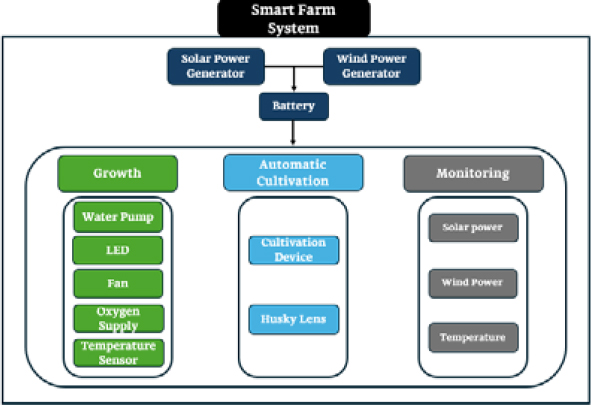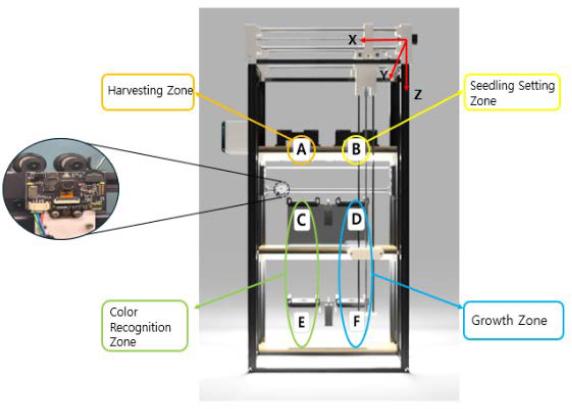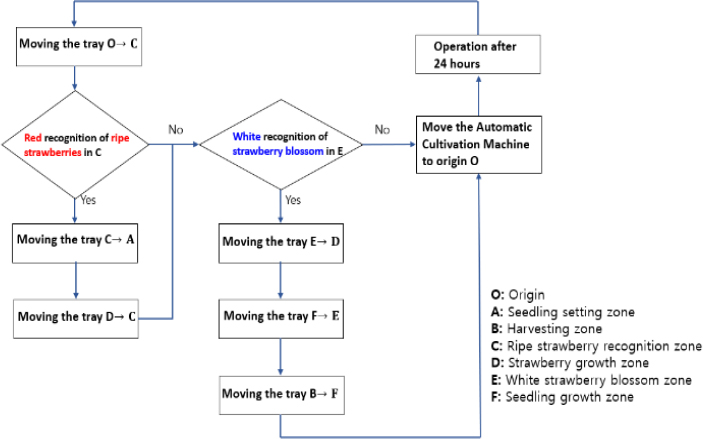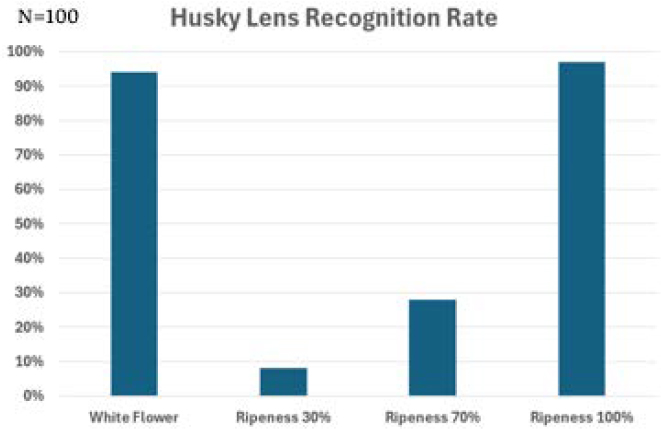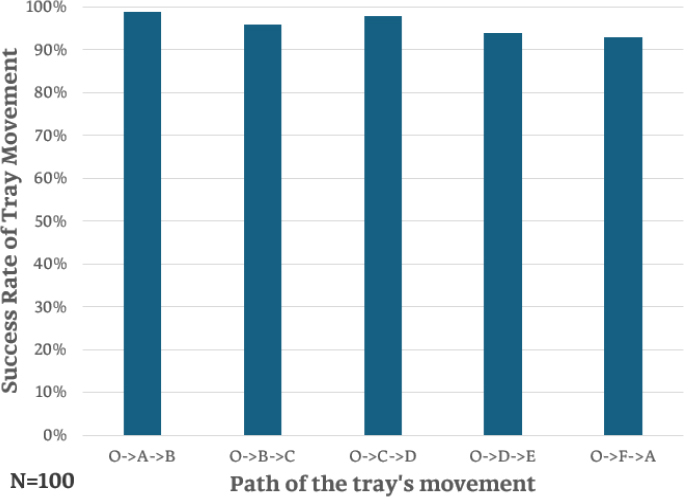
Tower-typed hydroponic smart farm using automated harvester
Copyright © The Korean Society of Marine Engineering
This is an Open Access article distributed under the terms of the Creative Commons Attribution Non-Commercial License (http://creativecommons.org/licenses/by-nc/3.0), which permits unrestricted non-commercial use, distribution, and reproduction in any medium, provided the original work is properly cited.
Abstract
This study proposes a hydroponic smart farm system with automated harvesting to address food production challenges caused by labor shortages in Korean agriculture. Unlike traditional smart farms, this system adopts a hydroponic cultivation method to enhance efficiency to manage growth environment and uses color recognition technology for automated harvesting, thereby reducing labor requirements. Additionally, a tower-typed structure is utilized to optimize the cultivation area. The automated hydroponic smart farm system consists of an automated harvester, control device to manage growth environment, a sensor detecting strawberry’s ripeness, and a monitoring component to facilitate smooth strawberry growth and automated harvesting. Experimental results confirmed the system’s stable operation and demonstrated that the tower-typed structure can increase crop yields by over 200% compared to conventional setups. This significant improvement highlights the system's effectiveness in maximizing cultivation efficiency within limited space.
Keywords:
Smart Farm, Automatic harvesting machine, Tower-typed structure1. Introduction
Agriculture, the foundation of human civilization, plays a critical role in both ecosystems and the economy. It encompasses all activities related to food and livestock production, remaining indispensable for human survival and development. Sustaining the agricultural industry requires a stable workforce. However, modern society is grappling with a severe labor shortage in this sector. However, modern society is facing a severe agricultural labor shortage. In South Korea, declining birth rates and an aging population have accelerated the decrease in agricultural labor, while rural populations continue to decline [1]. As the average age of rural residents rises, the issue of labor shortages intensifies.
To address these challenges, a novel agricultural technology known as smart farming has emerged. Smart farming integrates information and communication technologies (ICT) to automate and optimize agricultural production, management, and distribution processes. This approach not only improves efficiency and productivity but also enables precision farming and real-time decision-making [2]. Smart farms are increasingly recognized for their ability to enhance productivity and reduce labor demands in agriculture. By integrating renewable energy and hydroponic systems, they also address environmental challenges and improve energy efficiency. For example, recent studies have demonstrated the effectiveness of combining solar and wind energy in smart farm systems, achieving significant resource savings while maintaining optimal growth environments for crops [3].
By leveraging advanced technologies such as sensors, artificial intelligence (AI), big data, and the Internet of Things (IoT), smart farming systems enable real-time monitoring of crop growth environments and automatic adjustments of essential resources such as water, nutrients, temperature, and light to maximize crop productivity and quality [4].
Among the various cultivation methods, hydroponics stands out in smart farming for its resource efficiency and environmental sustainability. Compared to soil-based farming, hydroponics offers advantages such as soil erosion prevention, pest and disease control, and optimized water usage [5]. Strawberries are particularly well-suited to hydroponic systems integrated with smart farming technologies. Their distinctive growth stages and clear color transitions make them ideal candidates for automated harvesting systems. Figure 1 illustrates the growth stages of strawberries, from flowering to full ripeness. These stages are essential for implementing the color recognition system within the smart farm. Despite advancements in smart farming, existing systems predominantly focus on growth management, with harvesting remaining largely dependent on manual labor [6]. To address this gap, this study aims to design a hydroponics-based smart farm system specifically for strawberry cultivation, automating both growth management and harvesting processes. The proposed system incorporates a deep learning-based color recognition technology and an automated harvesting algorithm to accurately assess strawberry ripeness and initiate harvesting at the optimal time [7][8]. Through this research, the potential of smart farming systems to reduce labor dependency and improve productivity will be demonstrated, offering viable solutions to challenges faced by South Korean agriculture [9].
2. Integrated Components of the Smart Farm
The smart farm system proposed in this study is designed to comprehensively manage the growth, harvesting, and monitoring of strawberries. It comprises three main components: growth management, automated harvesting, and monitoring. Building on these three components, the system's overall structure and harvesting algorithm are designed to integrate their functionalities seamlessly. The smart farm structure optimizes the physical arrangement of components to facilitate efficient operation, while the algorithm ensures synchronized and automated processes for strawberry cultivation and harvesting.
2.1 Growth Management
The growth management component operates independently to optimize the environmental conditions for strawberry growth, focusing on factors like temperature, humidity, and water levels. As shown in Figure 2, the monitoring component tracks the environmental conditions that directly influence the growth of strawberries, such as temperature and humidity, while the automated harvesting system ensures that strawberries are harvested at the optimal time based on their ripeness.
The growth management component is designed to optimize and automatically control environmental conditions to ensure stable growth of strawberries. The system provides the following ideal environments for each component in crop development from flowering to fruit formation:
- i) LED Lighting: LED lighting ensures consistent illumination, stimulating photosynthesis and improving growth efficiency. By providing uniform light regardless of weather conditions, it supports the stable growth of strawberries.
- ii) Water Level Sensors and Pumps: Water level sensors and pumps detect water loss in the hydroponic environment and automatically adjust the water level to supply appropriate moisture to the strawberry roots.
- iii) Fans: Fans create airflow around the flowers, mimicking natural pollination processes and aiding in successful fruit formation.
- iv) Temperature sensor: Temperature sensors monitor the water temperature in the cultivation tank in real time, maintaining the optimal growth temperature for strawberries, which is 17–20°C. When temperature changes are detected, the system automatically sends alerts.
This growth management system continuously fine-tunes the conditions necessary for strawberry growth, ensuring efficient and stable development.
2.2 Automated Harvesting
The automated harvesting component functions independently, relying on color recognition and maturity data to determine the optimal time for harvesting strawberries. The automated harvesting component is designed to evaluate the ripeness of strawberries and automate the process of efficiently harvesting fully ripe fruit. This system consists of a color recognition device and an automated harvester, which work together to carry out harvesting operations based on the growth stages of the strawberries.
A HuskyLens AI camera module was utilized to evaluate the ripeness of strawberries through its built-in deep learning-based neural network. The device accurately distinguishes the white color of strawberry flowers and the red color of fully ripe strawberries, using color changes to determine ripeness.
While the specific architecture of the neural network model is not publicly disclosed due to proprietary reasons, the device is trained to recognize various growth stages, including flowers and strawberries at 30%, 70%, and 100% ripeness. It is installed at the rear of the smart farm where it moves along a timing belt to scan strawberries in each tray. When a strawberry is detected as 100% ripe, the HuskyLens module sends a signal to the automated harvester to initiate the harvesting process. Experimental results have shown that it achieves an average recognition rate of 95.5%, validating its reliability and effectiveness in the system.
The automated harvester is responsible for harvesting strawberries and transporting trays, operating accurately and stably within the smart farm using a linear guide system. Its structure is designed to insert arms into holes on both sides of the tray to securely transport it, preventing shaking or damage to the strawberries. The harvester moves along the x, y, and z axes, precisely reaching designated coordinates to complete harvesting tasks, after which the tray is moved to a new position and placed in standby mode for the next operation. By integrating tray transportation and harvesting tasks, the automated harvester ensures that the entire process is performed efficiently and seamlessly.
The color recognition device and the automated harvester work in synchronization to carry out the automated harvesting process seamlessly. The process begins with the color recognition device scanning the strawberries in the tray to evaluate their ripeness. If a strawberry is assessed to be 100% ripe, the device sends a command to the automated harvester, which then moves the corresponding tray to the harvest zone for processing. After harvesting is completed, the tray is relocated to a new position, and the vacant zone is replenished with new seedlings. Through this integrated process, the automated harvesting component minimizes the reliance on human labor while maintaining high precision and efficiency in its operations.
2.3 Monitoring
The monitoring component operates independently, tracking environmental factors such as temperature, humidity, and light to ensure optimal conditions for strawberry cultivation, supporting the system's overall efficiency. The monitoring component of the smart farm is designed to collect real-time data and present it to the user, thereby enabling effective management of the farm's operational status while ensuring the stability and efficiency of the system through energy management and environmental monitoring. This component plays a critical role in overseeing energy management and monitoring environmental factors to maintain the farm’s optimal operational conditions.
The system is powered by renewable energy sources, such as solar and wind power, with energy stored and utilized via batteries. The monitoring component facilitates energy management by collecting real-time data on power production from solar panels and wind turbines, providing users with data on energy generation to verify its adequacy, and issuing alerts if a decrease in energy production or anomalies are detected, thus allowing immediate corrective actions.
Environmental monitoring ensures the stability of the cultivation environment by managing key variables such as water temperature and lighting conditions in real time. The water temperature within the cultivation tanks is continuously monitored to maintain an optimal growth range (17–20°C); deviations from this range trigger automatic adjustments or user alerts. Furthermore, the operational status and intensity of the LED lighting system are continuously monitored to ensure that strawberries receive the necessary light for optimal growth.
The monitoring component integrates with mobile devices, such as smartphones and tablets, allowing users to access real-time data and remotely control the system if necessary. Users receive instant notifications for issues such as energy shortages or temperature deviations, and key data—including energy production, water temperature, and lighting conditions—are visually presented to facilitate the user’s understanding and effective management of the farm’s operations.
2.4 Smart Farm Structure
The smart farm is designed with a three-tier structure to provide optimal environments tailored to each growth stage of strawberries, adjusting environmental conditions for each layer to optimize the growth and harvesting processes (Figure 3). The first tier (Zones E and F) serves as the nursery zone, providing the environment necessary for the early growth stages of strawberries. This zone is dedicated to seedlings prior to flowering, supplying consistent light and moisture to promote healthy root and stem development through stable LED lighting and water pumps paired with level sensors to maintain proper moisture conditions. The second tier (Zones C and D) is the fruit formation zone, supporting the post-flowering stages of strawberry growth. Fans facilitate artificial pollination, promoting successful fruit formation, while optimal temperature and humidity levels are maintained to ensure smooth and robust fruit development. The third tier (Zones A and B) is the harvesting and storage zone, designed for collecting fully ripe strawberries and storing new seedlings. Zone A serves as the storage area for harvested strawberries, while Zone B stores new seedlings to be relocated to the appropriate zones as needed.
Special zones within this structure enhance functionality. Zones C and E serve as color recognition zones, where the device evaluates the ripeness of strawberries. Once full ripeness is detected, the automated harvesting system is activated to collect the strawberries. Zones D and F act as standby zones for strawberries before they are transferred to the color recognition zones. This integrated tiered structure allows the smart farm to operate efficiently, segmenting the growth and harvesting processes into distinct but harmonized stages that optimize the overall performance.
2.5 Algorithm
The automated harvesting algorithm of the smart farm operates through the integration of the color recognition device and the automated harvester, evaluating the ripeness of strawberries before carrying out harvesting tasks. The algorithm functions at a designated time each day and follows these sequential steps (Figure 4):
The process begins with the color recognition device moving to Zone C, where it evaluates the ripeness of strawberries in the trays. Once positioned, the device scans the strawberries in Zone C, waiting five seconds to complete the analysis. If a fully ripe (100%) strawberry is detected, the automated harvester is activated to transport the tray from Zone C to Zone A for harvesting, while the tray in Zone D is moved to Zone C. Simultaneously, the color recognition device transitions to Zone F to prepare for the next operation.
If no fully ripe strawberries are detected in Zone C, the color recognition device immediately moves to Zone F, where it evaluates the flowers to determine whether they are in a blooming state (white color). If blooming flowers are detected, the automated harvester is activated to transport the tray from Zone E to Zone D, while the tray in Zone F is moved to Zone E. New seedlings are then retrieved from Zone B and placed in Zone F. Upon completing these tasks, the color recognition device and automated harvester return to their initial positions, ready for the next cycle. If no blooming flowers are detected in Zone F, the color recognition device returns to its initial position, and the automated harvester remains on standby.
This algorithm operates on a 24-hour cycle, ensuring continuous automation of the smart farm's processes and maintaining efficiency and consistency in strawberry harvesting and management.
3. Experimental Setup and Results
3.1 Experimental Setup
An experiment is conducted to verify whether the color recognition rate of camera module falls within a practically usable range. The experiment categorizes strawberry maturity by tracking color changes in the fruit at different growth stages. The comparison groups are divided into blooming strawberries and strawberries at 30%, 70%, and 100% maturity levels. These stages were chosen to evaluate whether the system could effectively identify fully ripe strawberries (100%) while minimizing recognition of less mature ones (30% and 70%), which exhibit minimal red coloration. Camera module is trained via deep learning to recognize the colors of blooming strawberry flowers and fully ripe (100%) strawberries. Subsequently, the color recognition device attempts to identify flowers, as well as 30%, 70%, and 100% maturity strawberries, with each test repeated 100 times. The recognition rate is calculated based on the number of successful identifications.
An experiment is conducted to verify the accuracy and stability of tray transport in the smart farm when applying coordinate-based tray movement. This transport test gradually increases the travel distance, repeating sections of the harvesting algorithm to assess the success rate. The experiment is divided into five segments—O->A->B, O->B->C, O->C->D, O->D->E, and O->F->A—and each segment is repeated 100 times. Success is determined by whether the tray accurately reaches the specified coordinates. To evaluate the results, clear criteria are set for acceptable error margins and accuracy standards in the coordinate values.
3.2 Experimental Results
In this study, multiple experiments were conducted to evaluate the performance of the designed automated harvesting component.
First, the color recognition system integrated into the harvesting system demonstrated an average recognition accuracy of 95.5%, evaluated through 100 repeated attempts per test (N=100) for each growth stage (blooming, 30%, 70%, and 100% maturity). When tested across various color saturations, the recognition accuracy varied by 8% to 28%; however, this variation was within an acceptable error range, confirming that segmented cultivation and automated harvesting based on predefined criteria are feasible within the system. Figure 5 illustrates the recognition performance of the system at different growth stages. While the recognition accuracy for 30% and 70% mature strawberries is moderate, the system achieves a significantly higher accuracy at 100% maturity, as shown by the steep improvement in recognition rates. This trend underscores the system's reliability in identifying fully ripe strawberries, which are the primary target for harvesting.
Second, to reduce potential shaking and positional errors of the harvester during coordinate-based movement, the tray structure was optimized during the system design process. The accuracy of tray movement was tested with 100 repeated attempts (N=100) across predefined paths, as shown in Figure 6. Activating the automatic harvester recorded an average error rate of 4%, showing that the algorithm enables accurate path movement with minimal system errors.
These experimental results support the effectiveness of the proposed tower-type smart farm system in terms of automated harvesting, energy efficiency, and system stability.
4. Conclusion
The tower-typed smart farm system designed in this study has demonstrated its potential as an integrated solution capable of automated harvesting, energy efficiency, and stability. Experimental results confirmed the system's ability to achieve a 95.5% recognition accuracy for strawberry ripeness, and the optimized structure improved crop yield by multiple compared to conventional setups. By integrating renewable energy sources such as solar and wind power, the system addresses the challenges of energy consumption and labor shortages in traditional farming methods. Additionally, the use of a three-tiered structure optimizes space utilization and enhances productivity per unit area.
However, further research is needed to enhance the system's scalability and adaptability to other crops. Incorporating more advanced deep learning models could improve color recognition accuracy, and adding automated crop transportation features could further reduce labor demands. This study highlights the potential of smart farm systems to revolutionize modern agriculture by improving sustainability and reducing dependency on human labor. With continuous advancements, such systems could play a pivotal role in ensuring global food security and addressing climate change challenges.
This research aligns with previous findings by Muangprathub et al. [10], who highlighted the role of IoT and data analysis in enhancing smart farm efficiency. By leveraging IoT-based components and deep learning techniques, this study validates the potential of combining these technologies to automate and optimize agricultural processes. Similarly, Kim et al. [11] emphasized the importance of structural optimization in smart farming, and the tower-typed design presented here addresses spatial constraints while improving productivity.
Furthermore, Ljungberg et al. [12] demonstrated that machine learning applications can significantly enhance agricultural datasets, which parallels the use of the HuskyLens AI module in this study to achieve high accuracy in strawberry ripeness detection. Ryu et al. [13] also showcased the benefits of IoT-enabled automated farming systems, further supporting the practicality of this system in reducing labor dependency and ensuring operational stability.
Lastly, Walter et al. [14] emphasized the role of smart farming in sustainable agriculture, particularly through energy-efficient technologies. The integration of solar and wind energy in this system not only reduces operational costs but also addresses environmental concerns, making it a viable solution for sustainable food production.
First, incorporating additional deep learning techniques for enhanced object recognition could reduce recognition errors caused by interference around the Husky Lens, enabling more accurate and stable monitoring. This would refine the precision of harvest criteria, reduce harvester malfunctions, and contribute to overall productivity improvements. Specifically, precisely timed harvesting based on maturity levels would offer substantial benefits for quality control.
Second, introducing supplementary devices such as water temperature regulators to support the cultivation of a broader range of crops would allow for optimized environmental conditions tailored to specific crops. This would expand the range of cultivable crops and maintain high quality under various conditions. Consequently, the smart farm system's applicability could extend flexibly across diverse agricultural environments, from small farms to large-scale agricultural facilities.
Third, automating the transport of harvested crops by installing a conveyor belt on the third level would further reduce manual labor and enhance the operational efficiency of the smart farm. This improvement would increase processing speed for harvested crops, lower labor costs, and contribute to addressing workforce shortages.
Through these enhancements, the tower-type smart farm system could evolve into a more efficient and reliable automated agricultural solution. This system holds the potential to lead the future of smart agriculture, excelling in energy conservation, productivity, and multi-crop adaptability, and playing a vital role in ensuring a stable food supply and promoting sustainable agricultural practices.
Acknowledgments
This work was supported by the Regional Industry-linked University Open-Lab Promotion Support Project and the KMOU Academic research fund in 2024.
Author Contributions
Conceptualization, S. Jeon, J. Choi, I. Kim and J. Ko; Methodology, S. Jeon and J. Choi; Software, S. Jeon and J. Choi; Validation, I. Kim and J. Ko; Formal Analysis, S. Jeon, J. Choi, I. Kim and J. Ko; Investigation, S. Jeon and J. Choi; Resources, J. Ko; Data Curation, S. Jeon and J. Choi; Writing - preparation of the original draft, S. Jeon and J. Choi; Writing - reviewing and editing, I. Kim and J. Ko; Visualization, S. Jeon and J. Choi; Supervision, J. Ko; Project Management, J. Ko; Funding, J. Ko.
References
-
E. S. Mohamed, AA. Belal, S. K. Abd-Elmabod, M. A. El-Shirbeny, A. Gad, and M. B. Zahran, “Smart farming for improving agricultural management,” The Egyptian Journal of Remote Sensing and Space Sciences, vol. 24, no. 3, pp. 971-981, 2021.
[https://doi.org/10.1016/j.ejrs.2021.08.007]

- N. Srivastava, R. Kumar, and A. K. Singh, “Technological revolutions in smart farming: Current trends, challenges & future directions,” Computers and Electronics in Agriculture, vol. 198, 106874, 2022.
-
H. Kim, I. Kim, J. -W. Seo, and J. Ko, “Smart farm for hydroponic cultivation using integrated renewable energy systems,” IEEE Sensors Journal, 2024.
[https://doi.org/10.1109/JSEN.2024.3449344]

-
P. Angelov, S. Gupta, and R. Ramezani, “Sensors for smart agriculture: Applications and challenges,” Sensors, vol. 20, no. 15, p. 4231, 2020.
[https://doi.org/10.3390/s20154231]

- N. Wahab and R. Hashim, “Optimal plant growth in smart farm hydroponics using IoT and renewable energy,” ASTES Journal, vol. 5, no. 3, pp. 567-574, 2020.
- W. Yang, L. Chen, and X. Zhu, “A review of computer vision technologies for plant phenotyping,” Computers and Electronics in Agriculture, vol. 195, 106773, 2023.
-
Y. Park, S. Jeong, and C. Kim, “Smart farming innovations and opportunities,” Agriculture, vol. 13, no. 8, p. 1593, 2023.
[https://doi.org/10.3390/agriculture13081593]

- Y. Lin, Q. Wu, and Z. Zhang, “From smart farming towards agriculture 5.0: A review on crop data management,” Agronomy, vol. 12, no. 10, p. 1745, 2022.
- M. Alam, S. Hassan, and M. Jahan, “Application of IoT in smart agriculture,” Proceedings of IEEE International Conference on Advanced Networks and Telecommunications Systems (ANTS), pp. 567-574, 2020. [Online]. Available: https://ieeexplore.ieee.org/document/9108212, .
-
J. Muangprathub, N. Boonnam, S. Kajornkasirat, et al., “IoT and agriculture data analysis for smart farm enhancement,” Computers and Electronics in Agriculture, vol. 156, pp. 467–474, 2019.
[https://doi.org/10.1016/j.compag.2018.12.011]

- G. J. Kim and J. D. Huhl, “Trends and prospects of smart farm technology,” ETRI Journal, vol. 10, no. 1, pp. 23–35, 2015.
-
E. B. Ljungberg, O. Kajdanowicz, and M. Broda, “Machine learning applications on agricultural datasets for smart farm enhancement,” Machines, vol. 6, no. 3, p. 38, 2018.
[https://doi.org/10.3390/machines6030038]

-
M. Ryu, J. Yun, T. Miao, et al., “Design and implementation of a connected farm for smart farming system,” in Proceedings of the IEEE Sensors Conference, pp. 1–4, 2015.
[https://doi.org/10.1109/ICSENS.2015.7370624]

-
A. Walter, R. Finger, and R. Huber, “Smart farming is key to developing sustainable agriculture,” PNAS, vol. 114, no. 24, pp. 6148–6150, 2017.
[https://doi.org/10.1073/pnas.1707462114]



